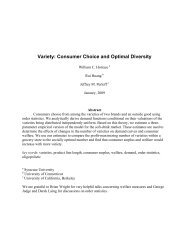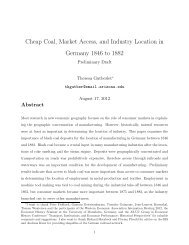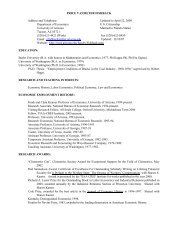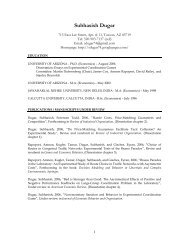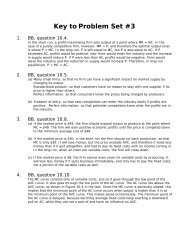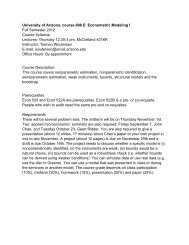A Dynamic Model of Demand for Houses and Neighborhoods
A Dynamic Model of Demand for Houses and Neighborhoods
A Dynamic Model of Demand for Houses and Neighborhoods
Create successful ePaper yourself
Turn your PDF publications into a flip-book with our unique Google optimized e-Paper software.
The time varying characteristics used in our application are rent, ground-level ozone (mea-<br />
sured in days exceeding the state st<strong>and</strong>ard), violent crime (measured in incidents per 100,000<br />
residents), <strong>and</strong> a measure <strong>of</strong> racial composition (percentage white).<br />
Rent (or user cost <strong>of</strong> owning a house) is typically calculated as a percentage <strong>of</strong> house value.<br />
We calculate neighborhood rent as 5% <strong>of</strong> a mean prices in the neighborhood. Rents, however,<br />
are clearly endogenous. The traditional approach to solving this problem is to use instrumental<br />
variables. Our approach to this problem is different. We use the estimate <strong>of</strong> the marginal utility<br />
<strong>of</strong> wealth found in Section 4.2 to recover the marginal disutility <strong>of</strong> rent. We assume that the effect<br />
<strong>of</strong> a marginal change in wealth on lifetime utility is the same as the effect <strong>of</strong> a marginal change<br />
in income on one period’s utility. In particular, the marginal utility <strong>of</strong> income (the negative <strong>of</strong><br />
which can be interpreted as the coefficient on rent) is given by γτ fmc . There<strong>for</strong>e we estimate the<br />
following regression where �γ τ fmc is known from Stage 2 <strong>and</strong> ˜ X denotes the non-rent components<br />
<strong>of</strong> X.<br />
5 Results<br />
δ τ jt + �γ τ fmc rentjt = ατ + αc + αt + ˜ X ′ jtαx + ξ τ jt<br />
The following section reports results. We estimate the model <strong>for</strong> whites only. The process could,<br />
however, be easily replicated <strong>for</strong> other racial groups, although small number problems may be<br />
more binding in first stage <strong>for</strong> minorities. Without an explicit analysis <strong>of</strong> the value <strong>of</strong> racial<br />
composition, racial groups could simply be pooled. We had 625 types, where types were defined<br />
by wealth <strong>and</strong> income, which were measured in $10,000 increments $0 to $240,000.<br />
5.1 Moving Costs <strong>and</strong> the Marginal Utility <strong>of</strong> Wealth<br />
In the second stage <strong>of</strong> estimation, the binary move/stay decision made every period was used<br />
to identify <strong>and</strong> estimate both psychological <strong>and</strong> financial moving costs. Using the outside in<strong>for</strong>-<br />
mation that financial moving costs are 6% <strong>of</strong> the selling price allows us to recover the marginal<br />
utility <strong>of</strong> wealth. The results <strong>of</strong> the second stage estimation are given in Table 5.<br />
26<br />
(21)



